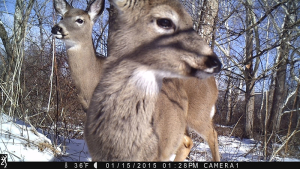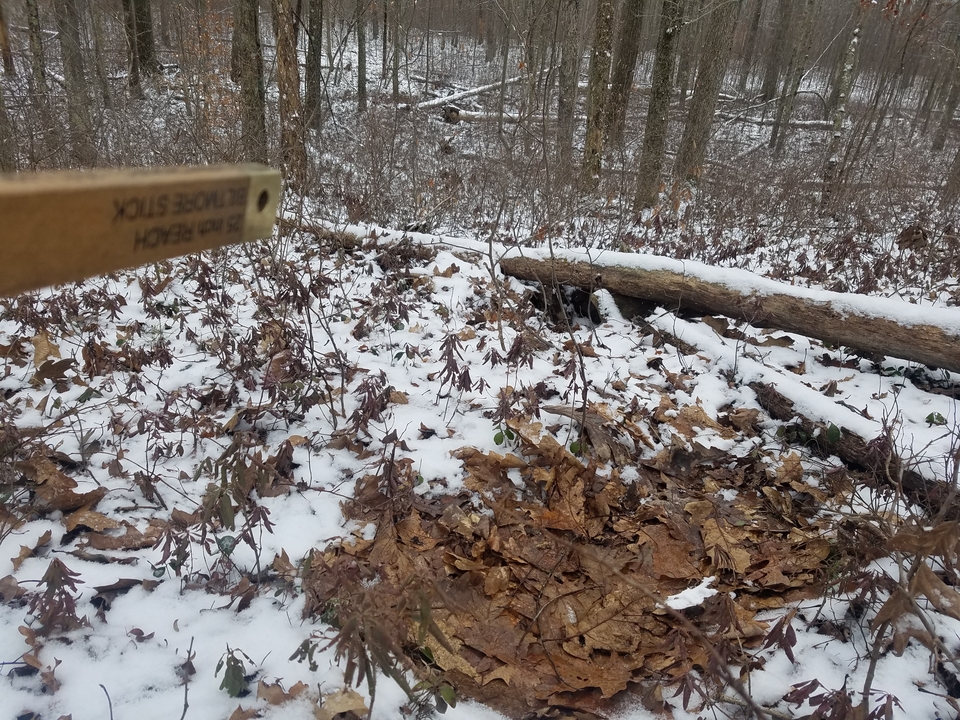How to Create Buck Bedding Areas
Buck bedding areas are not created but can be enhanced. The most important factor in a buck bedding area is the location and position on the terrain. The second factor is solitude and freedom from hunting pressure and social pressure from other deer. You can’t make a buck bed in a specific spot of your choosing. Buck bedding areas need these ingredients:
- advantageous terrain position – unapproachable without detection
- ground cover behind or around the spot
- view to the front, scent stream from the back
- escape avenue to bug out quickly (steep hill, heavy cover)
- Quiet solitude
How to Locate a Buck Bedding Area to Enhance – Terrain Position
The first then you need to do before firing up a chainsaw or planting anything is to figure out where bucks are currently bedding on the property. How do you do that? Well, this can be difficult but not impossible. Using winter snow cover to your advantage, go to the places you suspect will hold deer. Go places to try are sides of ridges on benches near the top of the ridge. Thickets on flat land where vegetation provides many acres of cover. Any visual vantage point where scent can blow to them from various directions, such as the top of a couple of hollows where they often come together, creating wind patterns from many directions.
Where a buck will bed depends on what terrain features and cover are available. The photo above shows a bed I stumbled upon while cruising timber. The property is fairly flat – up on the Pocono Plateau in Pennsylvania. However, this spot features a drop-off that offers a good view of the land downhill and some thick sapling growth behind it. The bed is large and there are no other beds near it so it can be assumed to have been a buck. Where I found doe beds, which I identified as smaller and several beds together, were in some saplings and tree tops left from previous logging.
What is the Difference Between Buck and Doe Bedding Areas
Not much except bucks, that is mature bucks don’t want to bed near other deer. Normally, a matriarchal doe will take the best food and cover location and all of her family group will hang out together. A buck of more than 2 or 3 years will not be welcome or wish to bed in the same area. During the mid – November estrus time, a buck will cut a doe that is receptive out and push her all over – away from her family group. She may seek thickets to try and shake the buck off from messing around with her until she ovulates. That is the only time you will see a buck bedded with or traveling with does.
Does will bed in the nearest cover available to the main food source. If there is no localized food source (food plot) then they will bed in thick cover with some structure wherever they find it.
I have found that bucks will be a lot more careful and more particular. This may be because does have many eyes and ears pointed in all directions to detect predators and they feel safer in numbers. A buck will find a place, especially when pressured, that provides the elements in the bullet points above. It is critical that he is able to relax and know that if danger approaches from any direction, he can detect it and bolt out of there in a hurry and put a lot of distance between him and the danger.

Enhancing Buck Bedding Areas
When I am trying to make bedding zones that are attractive to bucks, I like to go to the terrain feature they are know to like or I think they should like and make some ground cover with chainsaw and seed bag. I try to get some sun on the ground, get some trees down and tops for back cover and get some food planted to that there is a little bit of browse and some greens to munch on during the day. A deer will get up and feed a little every few hours and they wander off or just lay back down in the spot they like.
The idea is to make smaller zones scattered around. That way, there is not room for a doe family group to move into the spot. Make sure it is positioned in such a way that a deer can lay on the side of the “side cover” and look out or down a hill. There should be two ways to bail off the hill and run away. Ideally, the wind should come from the thicker stuff over the deer’s back so he can smell danger from that direction, be hidden and still see the way he is facing. Just below the crest of a ridge, the nose of a side ridge, the edge of a bowl, are all good places to try and house a buck during the day.
Hinge Cutting for Deer Bedding Cover
If you have species that are fibrous such as oaks, hickories, hophornbeam, locust then you should use hinge cutting to enhance cover. I have made good buck bedding by getting 300 yards from the food up the hill and dropping a bunch of yellow poplar. They don’t hinge over but they have nice big tops and create lots of side cover. Point is, hinge cutting is not always possible or necessary. The important thing is to get some side cover on the ground, some structure. I once was cruising a tract in OH that was wide open timber. There was a tree top that broke off on a ridge and landed near where the ground dropped off – sure enough, that little bit of structure in the right terrain had a deer bed next to it. Se what they like and make more of it.
Bucks bed in these spots where I made a mess in open timber. It is very predictable to see bucks come out of these areas toward the food. The does are usually bedded in the thick stuff I made through TSI thinning and regeneration very close to the food plot.
Solitude
Deer in general and especially mature bucks prefer to spend the day in a spot where they NEVER smell, hear, see a human or any predator. Having said that, I have tracked bucks to their beds on a high spot near a logging job. For some reason, the most elusive animal in the world will set up just off a logging job in the winter and watch the equipment go by and hear, see and smell people. The food is so good, they wait until the loggers go home and come in to feed on buds in the tops of felled trees. But, when there is any pressure and food is plentiful, a buck will go to a remote, quiet location where few men dare to go. Tops of steep nasty thick ridges are where they will be. And you can bet they will not be approachable at this spot. Radio collared bucks over 2.5 years old have proven this. These bucks go to a secluded spot where they know they wont be disturbed and stay there for days without leaving at all. After getting good and hungry, and most hunters have given up and gone home, they will wander around and feed.
Setting up Ambush Points
A very small food plot somewhere in between the buck bedding and the main food source enhanced with a water hole, licking branch and scrape will be your ambush spot. A buck may get up and go there to get a bite if he is restless and will certainly stop there to hit the licking branch and get some chow while still under cover. Some water at this spot will be attractive on hot October evenings and also late morning when the chase phase of the rut is on. Hunting the main food source is not a good practice.
For more on creating habitat for deer check out my youtube videos here: Deer Habitat Improvement Video

